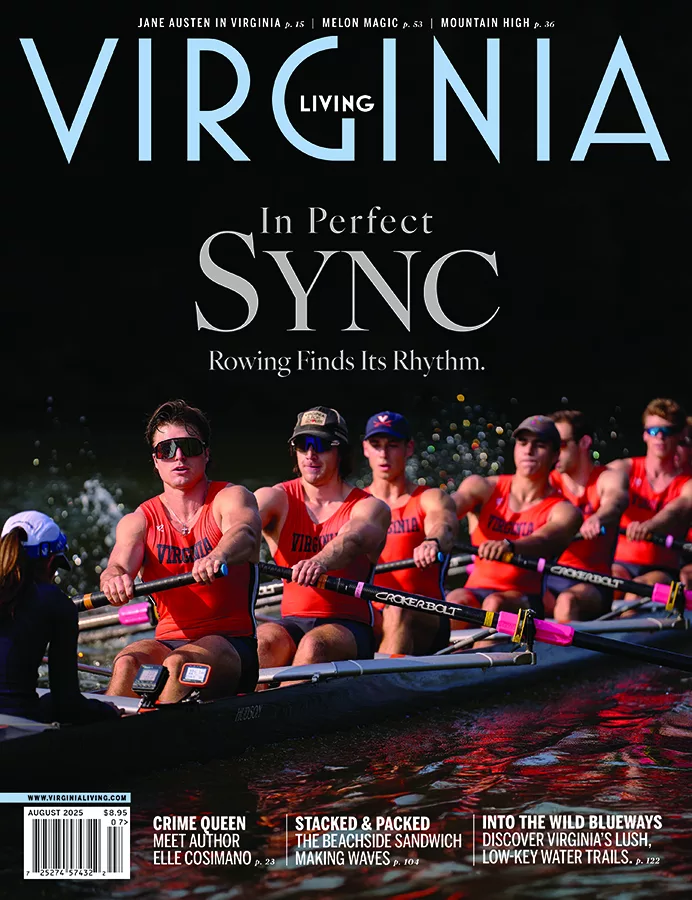Tractor pulling is about power, ingenuity and raw determination, having originated in the days when farmers vied for bragging rights to owning the strongest horse.

Bill Bolderson pulls the sled down the track at Dragon Motorsports Park in Dunnsville.

David Hall edges his Chevy, “Part Time Hooker,” into position.

David Harner, president of Shenandoah Valley Tractor Pullers Association.

Boogity Boogity doing a wheelie.

Amanda Kaplett

2013 Champ, John Kuykendall on left, with Nathan.
Twilight has descended over Dragon Motorsports Park in Dunnsville, and the center of attention—a clay track 30 feet wide by 320 feet long—is illuminated by a series of lighted telephone poles. An enthusiastic crowd of several hundred people sits clustered on low metal bleachers and huddled against the quickly cooling night air in the beds of pickup trucks parked in an adjacent field. Everyone grows silent as a prayer comes over the loudspeakers, followed by the national anthem. Behind the bleachers, the breeze rustles a long string of Confederate and Gadsden flags, the latter’s familiar coiled rattlesnake warning, “Don’t Tread on Me.”
“Are you ready for some pulling?” the announcer bellows. His call elicits applause from the multi-generational crowd—families to 20-somethings. An excited grade-school boy comes tearing out of a portable toilet, whooping and letting the door slam shut behind him.
Suddenly, the only thing audible is an engine—its roar fills the air. David Hall of Warsaw has edged his black, 4-wheel-drive Chevy truck to the starting line. Bearing the name Part Time Hooker, the truck reverses on the clay track and gets “hooked” via chains to a 42,000-pound metal sled, which is similar to a long, flat trailer, but with an operator sitting in an enclosed cockpit above its tail end, ready to hit an emergency cut-off switch if necessary. Hall, like all of the competitors this evening, hopes to pull the sled as far as possible down the track, ideally going all the way to achieve a full pull. The sled (and physics) will be working against him. Using 27 different gear selections, the sled’s operator will shift a variety of weights forward at the same rate during each competitor’s pull, slowly increasing friction by forcing the front of the sled into the dirt track.
The rumble of the truck’s engine climbs, part thunderclap and part dentist’s drill. The pull attempt goes well … too well. Hall ends up lugging the sled more than 323 feet, and that’s too far for the organizers’ liking. Full pulls should be tougher, more difficult, so they “tighten up” the sled so that its weights will move forward faster and competitors will bog down sooner.(For fairness’ sake, Hall will get to try again later.)
The tightened sled takes its toll on the next competitor. Heart Attack, a blue Chevy truck emblazoned with a painted eagle and a man’s muscular arm, unleashes a deafening roar as it barrels down the track with the sled rolling behind like a toy. Then the truck’s engine dies, and the sled grinds to a halt at only 182 feet.
“We’re gonna need a tow vehicle out on the track,” says the announcer, John Nicol of Prince George County, who has been announcing for Dragon Motorsports for eight years. “Something definitely went wrong.
”But from the crowd’s point of view, everything is just right. They’ve come to this rural tract of land just west of the Rappahannock River on a beautiful Saturday in April to witness a loud, exhaust-spewing truck-and-tractor pull. And seeing a vehicle break an axle or belch fire can be even more exciting than seeing one succeed. Truck pulling, along with its older sibling, tractor pulling, is not about speed; it’s about distance and power. But perhaps even more so, it’s about effort. As a sport and as a culture, pulling rewards those who willingly shoulder a difficult load, dig into the dirt and go as far as they can. It is, as they say, the world’s heaviest motorsport.
It’s “pretty awesome,” says Alicia Haggard, 23, who came to Dragon Motorsports Park with friends for her first-ever pull. Haggard, who works at Tuckahoe Orthopaedics in Richmond and plans to take classes this fall at J. Sargeant Reynolds Community College, anticipated a party atmosphere at the park, with few people paying attention to the trucks. As it turned out, the overwhelming noise and dust-spewing action commanded attention.
“It was exciting—more than I thought it would be,” she says. Lounging with Haggard in the back of a pickup is Maria Gregory, also 23, who works at Mike Kelo Physical Therapy in Chester. Gregory grew up on a farm in Mechanicsville, and she and her dad have attended many pulls together. Although her male friends would rather watch four-wheel-drive trucks compete, she prefers tractors.
“I like how the old Internationals sound,” she says, referring to the powerful, antique International Harvester brand. “It’s exciting—it gets you going.
”Randa Jackson agrees, having seen the effects herself.
During pulls, “you see old guys yelling and making the sounds of the trucks,” says Jackson, spokeswoman for the Powhatan Fair, which has featured a tractor and truck pull several years in a row. “They turn into little kids. And the little kids are jumping and yelling because their parents and grandparents are so excited.”
Pulling originated in the late 1800s when American farmers competed to determine who owned the strongest horses. Contests included pulling heavy wagons or barn doors laid flat and weighted down by friends and neighbors. By the 1930s, horses had given way to stock tractors. It’s likely that the first tractor pulls were in Missouri and Ohio.
Although truck pulls are the bigger draw these days, both tractor and truck events have maintained a foothold in Virginia and other agricultural areas of the country. They’re mainstays of fairs and rural fundraisers throughout the Commonwealth. Dragon Motorsports, for example, one of only a few such promoters statewide, has 30 pulls scheduled this year between April and September. And during the same time period, Stuarts Draft-based nonprofit Shenandoah Valley Tractor Pullers Association raises money for charity by putting on pulls at events like the Fredericksburg Fair, an oyster roast in Hanover County and a benefit for a volunteer fire department in Lexington.
Pulling events in general have come a long way. Trucks—and, to a lesser extent, tractors—often feature huge tires, enhanced safety features and modified engines (sometimes more than one engine per vehicle). They run on everything from gasoline and diesel to alcohol and jet fuel. The most powerful trucks can pull sleds weighing up to 65,000 pounds. The National Tractor Pullers Association (NTPA), a governing body in Columbus, Ohio, now recognizes 14 competition classes, including Modified Tractors, Super Modified Four Wheel Drive Trucks and Pro Stock Semi, just to name a few. And yet tractor and truck pulls still express a defining aspect of their rural Midwestern origins more than a century ago. Families and friends still love getting together in wide-open spaces to socialize, snack, drink and compete—all the while celebrating the power and ingenuity that goes into building and driving tractors and trucks.
In the early 1970s, Hylton Clark was teaching vocational agriculture at Winchester High School and looking for a novel way to raise money for the local Future Farmers of America chapter. One of his students suggested a truck pull.
“We kicked it around a bit and decided to try it,” recalls Clark, now 71.
They held their first event in 1974 at the Stonewall Ruritan Grounds, pulling Big Bertha, a sled they’d built in the high school’s 4-H shop. The next year, they organized five pulls.
Clark and five other drivers in Winchester eventually formed a pulling group distinct from the high school, and they rented a better sled. Their competitions began attracting pullers from around the state. “It was always, ‘If you could win at Winchester, it was a big deal,’” Clark recalls. It wasn’t long before Winchester was America’s hub for truck pulling—the NTPA even calls Winchester “America’s truck pulling capital.”
Forty years after the first Winchester truck pull, Clark is still competing. Though he has narrowed his role to mechanic, his wife, Charmayne, took his place in the driver’s seat of their ’66 Chevy truck 20 years ago. She is now 57.
Dragging a heavy sled with a powerful truck is inherently risky, as Charmayne has experienced first-hand.“
The ignition cut out one night,” she says. “The sled hit the back of the truck and pushed me forward, and I hit the steering wheel with my chest. Every time, I say a little prayer that the engine will stay together.”
Now when she pulls, she wears a three-point safety harness, a helmet and fire-retardant clothing. The danger doesn’t seem to faze the affable and matter-of-fact Charmayne, who frequently peppers her emails and social media posts with references to her strong faith.
But Charmayne also knows that risk can lead to reward. Hundreds of Virginia pullers compete each year—in some cases against thousands more from other states—and the annual points champion in each truck class can earn as much as $10,000 at year’s end. It sounds like a lot, but top pullers can spend up to $100,000 to prepare a truck for competitions. In addition, the Clarks say they spend about $40,000 a year for engine repairs and upgrades.
Similarly, John Kuykendall, a 29-year-old commercial HVAC installer from King George County, says he has funneled $30,000 into his ’95 Ford truck. He competed in almost every Dragon Motorsports pull in 2013 and ended the year as that company’s points champion in the 8050 Diesel class. “It’s about consistency,” he says. “That’s all my schedule is, all summer long.”
Sponsorship can ease the financial burden of pulling. As owners of three Snap-on tool franchises before they retired, the Clarks have sponsored themselves for decades. “So we’ve been fortunate in that respect,” Hylton says.
But it’s not all about competition, says Charmayne: “We don’t go to bars. We don’t go to health clubs. It’s our escape to get away for a few days. And there are so many connections we’ve made out there, it becomes a family.”
Glenn Riggleman, a retired corporate truck driver, drove from Harrisonburg with his 14-year-old grandson in late March to compete during the 34th-annual Shuk-n-Pul at the Courthouse Ruritan Park in Hanover County. Organized by the Hanover Ruritan Club and featuring members of the Shenandoah Valley Tractor Pullers Association, the event, which includes an oyster roast, supports local fire and rescue squads.
Waiting for his turn to pull a 10,000-pound sled, grandson Gabriel sits astride his 1972 Sears tractor, Easy Greasy, sporting braces and a camouflage jacket. (Tongue-in-cheek vehicle names like Easy Greasy, Widow Maker and Hardly-Able are common in pulling, and they give drivers and mechanics a chance to express their outlook—whether on life, the competition or both.)
For his part, Gabriel offers a laid-back philosophy about pulling: “You’ve just got to think positive. You hold the brake down until they raise the green flag. Then you ease off on the clutch, and then mash on the gas.”
Glenn Riggleman looks on, smiling. “We’ve been talking about this for a month now—to get out of the house and get away. When my cell phone rings here, I don’t answer it.”
As Glenn and Gabriel wait their turn, Travis Gilpin watches the garden-tractor competition with his 28-year-old sister, Kendrea Gilpin, and her 4-year-old son, Kameron Jones. Travis, a 30-year-old window installer from Beaver Dam, had previously attended truck and tractor pulls during the Virginia State Fair at Meadow Event Park.
“It’s something good for the kids to watch,” he says.
And participate in, too. Just then, 9-year-old Andra Wilson-Wade from Waynesboro comes chugging down the clay track looking determined at the helm of a red, 1976 garden tractor called Fire Horse in the 900-pound class. Afterward, he removes his helmet and softly says hello.
Shy by nature, Andra (pronounced André) is an only child and was diagnosed as having ADHD, says his mother, Octavia Wade. Figuring that an active, social hobby would help him, she bought him a go-kart. After attending a truck and tractor pull for the first time, however, Andra wanted to trade his go-kart for a tractor. He started competing in pulls last year.
“He was scared of it at first,” Octavia says. “But after a few times, he got over that.”
She, too, was apprehensive: “The first time he pulled, it scared the living daylights out of me. Now I enjoy it. I kind of want a tractor for myself.”
Tractor and Truck Pulling Resources
Central Virginia Antique TractorPulling Association- CVATPA.com
Lucas Oil Pro Pulling League- ProPulling.com
National Tractor PullersAssociation – NTPAPull.com
Shenandoah Valley TractorPullers Association- SVTPA.com
Wanta-Pull Productions- WantaPullProductions.Webs.com









